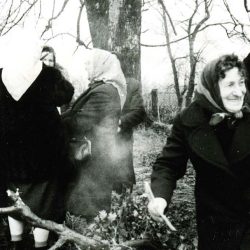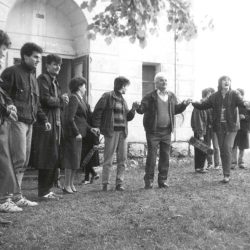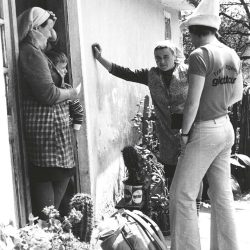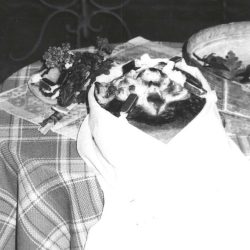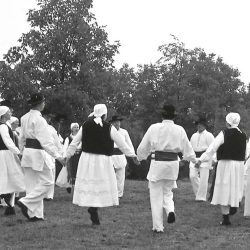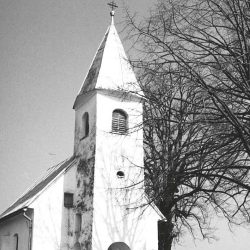Sing to Me, Sing, Falcon: Song Heritage of the Uskoks in White Carniola
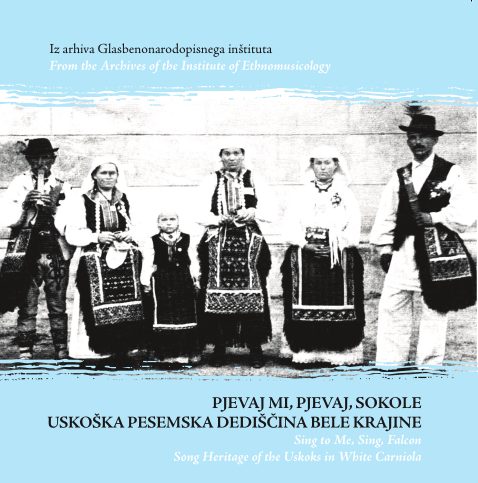
GNI M 36.929; UPD 362
Recorded: Bojanci, 1976
Sung by: Zorka Vrlinič (lead), Simon Vrlinič, Ljuba Vrlinič (née. Kordič), Niko Vrlinič, Ljuba Vrlinič (née. Radojčič), Zlata Vrlinič (née. Žužinjak), Simo Radojčič, Bosiljka Radojčič, Ljuba Vrlinič (née. Mikunovič)
This song was usually sung while dancing or during social get-togethers, in which short and improvised two-line stanzas were used to spread declarations of love, news, and various humorous events. These humorous songs are known as bečarci (literally, ‘bachelors’ songs’) and were also popular among the Serbs in White Carniola. For more on these songs, see the note to song no 25.
GNI M 24.502; var. UPD 23/a
Recorded: Predgrad, 1961
Sung by: Meta Štaudohar, Marjeta Smuk, Katica Bižal
In the Poljane Valley along the Kolpa River, this was a dance song by function and a true ballad in the original sense of the word. It was sung while dancing in a circle on St. John’s Day (27 December). In terms of content, this is a ballad with an internationally known fairytale motif of three witches (or fairies among the South Slavs) that tear out a young man’s heart. In the White Carniolan versions, one can still discern the mythological background, which of course is no longer perceived today. At the symbolic level, the song has shifted to an emphasis on love: the young man chooses among his mother, sister, and lover, and decides on the lover; he gives his heart only to her or only she can “steal” it away. Versions of songs about three fairies that tear out a young man’s heart have also been recorded in Istria, Dalmatia, and Serbia. This song and the associated dance also came to White Carniola with the Uskoks from the Cetina area of Dalmatia. In Predgrad, this song is usually sung in its entirety with several stanzas (see Kumer, 1970: 140), whereas the version presented here is somewhat shortened.
GNI M 45.938; UPD 11
Recorded: Marindol, 1991
Sung by: Marija Bunjevac (née Stipanovič)
The widespread motif of a human victim sacrificed like a lamb predominates in this “outlaw song”; this motif is already known from the Biblical story of Abraham. In South Slavic (especially Serbian) folk literature, the basic motif is often connected with the cruel brigand Manojlo Grgić. His name is no longer preserved today and so the song only emphasises the human victim. The song was introduced from Bosnia during the interwar period and is also known among the Serbs.
GNI M 36.955; UPD 221
Recorded: Bojanci, 1976
Sung by: Simon Vrlinič (lead), Zorka Vrlinič, Ljuba Vrlinič (née Kordič), Niko Vrlinič, Ljuba Vrlinič (née Radojčič), Zlata Vrlinič (née Žužinjak), Simo Radojčič, Bosiljka Radojčič, Ljuba Vrlinič (née Mikunovič)
This song has a known creator and was composed in Kordun during the Second World War. It was incorporated into folk heritage even during the war because the author had relied on older forms of Croatian and Serbian lyric folk song. Among other things, she used the old folk verse form of the octameter (4 + 4) and relied fully on the poetics of Serbian folk song. White Carniolan Serbs were also connected with the Serbs in Kordun through family history and had already heard this song during the war either from their relatives or in the Partisan units; this song then became part of their heritage.
GNI M 45.553
Recorded: Deskova vas near Stari Trg, 1989
Sung by: Katarina Antič (née Mihelič)
This song uses its opening verses to provide a temporal and spatial framework to the events taking place in the Balkans during the First World War. However, war only served to elicit the old topic of the soldier (or husband) gone to war, who comes back to his wife after many years away. This topic is thus older, more general, and also known in Slovenian folk song. It is a ballad about a faithful wife that waits for her husband and does not remarry, even though she is told that her husband was killed. The version presented on this audio publication is from Croatia.
GNI M -; UPD 71
Recorded: Miliči, 1989
Sung by: A group of locals
This song is sung today not only by Serbs in White Carniola, but also in Croatia and Serbia as a wedding or ritual song, by analogy with the wedding guests described in the song. However, in terms of content, which in this case is slightly truncated or adapted to a wedding, this song belongs among the old European family ballads about the wicked mother-in-law that murders her son’s bride on the wedding day. In addition to the lyrics, the verse form (i.e., the epic decasyllable, 4 + 6) also suggests that this is a ballad. This recording has a slightly poorer technical quality and the first two words in the opening verse are missing because it was made outdoors, when the people of Miliči gathered in front of the church after the Orthodox Christmas mass, danced in a circle, and sang. This recording thus functions as documentation of living heritage.
GNI M 36.928
Recorded: Bojanci, 1976
Played by: Niko Vrlinič
Although the people of Bojanci also danced to the music of tambura players, they usually used simpler homemade musical instruments or less expensive purchased ones. These included the harmonica.
GNI M 36.927; UPD 268
Recorded: Bojanci, 1976
Sung by: Simon Vrlinič (lead), Zorka Vrlinič, Ljuba Vrlinič (née Kordič), Niko Vrlinič, Ljuba Vrlinič (née Radojčič), Zlata Vrlinič (née Žužinjak), Simo Radojčič, Bosiljka Radojčič, Ljuba Vrlinič (née Mikunovič)
This song, which is known across the entire Croatian- and Serbian-speaking area, acquired its own version of the motif among the Serbs in White Carniola. In a very concise manner it reveals what the girls would choose from among a ring, a field, and a boyfriend. Love always wins.
GNI M 35.409; UPD 16/a
Recorded: Žuniči, 1975
Sung by: Marija Žunič, Ana Starešinič, Anica Starešinič (Srečina)
This is most likely an older ballad about family conflicts that has changed over time. Only the motif of the cruel brother that slays his sister has remained. However, the crime remains unsolved because even in the past the singers probably began to leave this part of the song out and focused only on the tragic event (i.e., the murder). The Croatian versions (the song was introduced to White Carniola from Croatia) also do not say anything about the reasons for the murder. Based on the entire thematic context of family ballads from the Balkans with similar motifs, it can only be presumed that the murder happened due to the brother’s possessive and protective nature or perhaps even due to incest, but these are merely speculations. The singers feel and sing the song in its present form, modified though it may be, as a whole and as part of the heritage that was passed on to them from their ancestors. A young Croatian woman that moved to Žuniči in White Carniola when she got married taught this song to other women living there.
GNI M 36.924; UPD 355
Recorded: Bojanci, 1976
Sung by: Simon Vrlinič (lead), Zorka Vrlinič, Ljuba Vrlinič (née Kordič), Niko Vrlinič, Ljuba Vrlinič (née Radojčič), Zlata Vrlinič (née Žužinjak), Simo Radojčič, Bosiljka Radojčič, Ljuba Vrlinič (née Mikunovič)
The first transcriptions of this song from Croatia and Bosnia date back to the nineteenth century. This love song became most popular in Bosnia, and it remains part of the repertoire of Bosnian folk singers even today. Prior to the Second World War, it was also popular among men from Bojanci and Marindol doing their military service in Bosnia; at that time, the song also spread among the White Carniolan Serbs.
GNI M 24.461; UPD 234
Recorded: Špeharji, 1961
Sung by: Marija Lakner
This song came to White Carniola from near Karlovac, but its musical character reveals that it originates from the Kvarner Gulf area or the Littoral-Istria region; it was there that the majority of versions have been recorded. Ultimately, its lyrics also refer to the sea: from afar, the women (the mother, sister, and girlfriend) can see their beloved young man on the galley because they recognise him by the shirt that his mother cut out, his sister sewed, and his girlfriend ironed. The song spread to White Carniola from nearby areas in Croatia.
GNI M 36.938; UPD 239
Recorded: Bojanci, 1976
Sung by: Simon Vrlinič (lead), Zorka Vrlinič, Ljuba Vrlinič (née Kordič), Niko Vrlinič, Ljuba Vrlinič (née Radojčič), Zlata Vrlinič (née Žužinjak), Simo Radojčič, Bosiljka Radojčič, Ljuba Vrlinič (née Mikunovič)
Like the majority of the songs that people of Bojanci sing today, this one also came to White Carniola relatively late: in the first half of the twentieth century. It was introduced by a local that had done his military service in Bosnia. The song is not Bosnian in origin because it is only known by Serbs and Montenegrins.
GNI M 44.117; var. UPD 44
Recorded: Dolenjci near Adlešiči, 1987
Sung by: Anica Bahorič and Marica Bahorič
In the book Uskoška pesemska dediščina Bele krajine, this version of the song is published under number 44; it was transcribed in 1880 in Adlešiči. The song was introduced to White Carniola from Croatian Military Frontier or Kordun. The first transcriptions were made near Slunj, from where it spread across the entire Croatian- and Serbian-speaking environment.
The song is also known in Međimurje, where it was introduced by the Uskoks. This shows that the song is much older than the first transcriptions indicate. Its proper age is also suggested by the lyrics because this is a slightly shortened ballad using a version of the ancient Odyssean motif of a slave chained to a galley. This international motif has taken on various versions, additions, and shortened forms in various environments. The old motif presumably began to break up when singers began emphasizing a slightly different, more lyric motif and the song was transferred from an epic environment to a lyric one. Compared to Croatian and Serbian versions, the White Carniolan ones show that the initial dialogue structure is no longer part of a wider epic event, but focuses on the hero’s tragic position. The young man (the galley slave) provides lyric and allegorical answers to the girl’s questions. It is interesting that in White Carniola this Serbian/Croatian song was preserved by Slovenian singers and that both versions were only transcribed in Slovenian places. This may explain the truncation of the older epic form and content. In the Slovenian environment, the song’s musical effect has also been completely altered because the Slovenian singing style is completely different from that used in ballads with decasyllabic verse, either in Croatia or Serbia. It seems that the song has long been present in White Carniola because not only its melody and lyrics, but also its language, have become Slovenian. Slovenianized versions of this song are also known in Prekmurje, to which it was introduced from Međimurje.
GNI M 36.945; UPD 277
Recorded: Bojanci, 1976
Sung by: Zlata Vrlinič (née Žužinjak)
A singer that married and moved to Bojanci from the Croatian settlement of Ponikve learned this song in her home town. This seems to be a relatively recent song, which is also suggested by its melody. Its lyrics are based on the eternal theme of the rich lover that chooses a poor girl. The verse (i.e., a symmetric dodecasyllable, 6 + 6) also shows that this could be an art song that was incorporated into folk heritage. This type of verse pattern is not commonly found in Serbian and Croatian folksongs.
GNI M 24.491; UPD 153
Recorded: Stari trg, 1961
Sung by: Kristina Majerle (née Šubašić) and her neighbor
The singer Kristina Majerle introduced this song to Stari Trg ob Kolpi from Croatia, where she was born, before the Second World War. She also passed on her singing repertoire to the White Carniolan folkdance groups that she headed. The mention of Vrbnik in the song and especially the typical Kvarner Gulf melody testify that the island of Krk is most likely the song’s birthplace; the song is also known in Dalmatia, Dalmatian Zagora, and Istria.
GNI M 35.406
Recorded: Žuniči, 1975
Sung by: Marija Žunič and Anica Starešinič
This song about a girl bidding farewell and then sending greetings to her boyfriend, a soldier, was introduced to Žuniči by a singer from Prilišće, Croatia that married into the village. The Slovenian villagers learned it from her. Other versions of this song are also known elsewhere in White Carniola because young men that did their military service in Bosnia also sang it before the Second World War.
GNI M 24.445; var. UPD 1
Recorded: Predgrad, 1961
Sung by: Meta Štaudohar, Ana Jordan, Katarina Štrk
Similar opening lines can be found in many Serbian heroic songs, but the version presented here is too truncated to draw any comparisons. Song no. 1 in the volume Uskoška pesemska dediščina Bele krajine can be referred to here. It can only be stated with certainty that this version is a fragment of a longer Serbian or Croatian epic song that has been preserved among today’s descendants of the Uskoks in Predgrad; along with this fragment, they have also preserved the epic decasyllable verse type, although the melody has already been slightly “Slovenianized.”
GNI M 36.921
Recorded: Bojanci, 1976
Played by: Niko Vrlinič
This is a dance melody that the White Carniolan Serbs used for circle dances. A modified form of this dance is also known elsewhere in Slovenia: it was popularized as part of the reading-room movement in the nineteenth century and by various cultural societies during the interwar period; today, it is performed by folkdance groups that probably received it from Bojanci (Kunej R., 2008: 18).
GNI M 37.207; UPD 41
Recorded: Krašnji vrh, 1977
Sung by: Danica Ratkovič
This is another truncated love ballad, this time about a shepherd that is cheated out of a kiss from a girl even though he has helped her. The epic decasyllables also indicate that this is an older ballad form. Various versions of this song are known throughout Croatia, and the song is also known by Croatians in Vojvodina and in Kosovo. It was introduced to Slovenia from neighbouring Žumberak in Croatia.
GNI M 36.936; UPD 363
Recorded: Bojanci, 1976
Sung by: Simon Vrlinič (lead), Zorka Vrlinič, Ljuba Vrlinič (née Kordič), Niko Vrlinič, Ljuba Vrlinič (née Radojčič), Zlata Vrlinič (née Žužinjak), Simo Radojčič, Bosiljka Radojčič, Ljuba Vrlinič (née Mikunovič)
The people of Bojanci borrowed this humorous love song from their compatriots in Dubrava near Ogulin, Croatia. Due to technical shortcomings, the last stanza is not included on this audio publication. The song’s lyrics are published in full in the volume Uskoška pesemska dediščina Bele krajine.
GNI M 26.036; UPD 274
Recorded: Stari trg, 1963
Sung by: Ivanka Štrbenc
Some Ikavian elements suggest that the song was introduced to White Carniola from the Croatian Littoral; however, over time it has become considerably Slovenianized, not only in terms of language but also content, because the emphasis is on “patriotic” sentiments in love. The boy turns down a girl from Edirne (a Drinopoljka) because he has already chosen a Slovenian girl instead. The melody is also of recent origin and almost has a choral character. This song is definitely newer, which is also suggested by the octameter-pentameter couplet, which is rare in folk songs and only appears at the end of the nineteenth century under the influence of art songs. This is a modern stylization of an older ballad with a love theme. A similar version was recorded in 1914 in Adlešiči (cf. Kunej D., 2008a). Versions similar to that from Adlešiči can also be found in the area between Sisak and Istria, and between Žumberak, Croatia and Krupa, Bosnia.
GNI M 28.347; UPD 261
Recorded: Bojanci, 1967
Sung by: Zdravko Vukčevič
The people of Bojanci sang various songs during circle dances: lyric, especially love and humorous songs, ballads, and “proper” dance songs. This is a lyric song with the generally known motif of a mother that does not approve of her daughter’s fiancé. The majority of these songs end tragically, with fierce family conflicts, whereas this version is more humorous; the question is whether it was like this at the time of its creation or has changed over time. Perhaps this is again a truncated ballad, as suggested by the epic decasyllable. Transcriptions of similar versions can be traced back to the nineteenth century across all of Serbia.
GNI M 45.524; UPD 293
Recorded: Stari trg, 1989
Sung by: Kristina Majerle, Katarina Mihelič, Lucija Rom, Ivanka Mihelič
This song is part of the repertoire of Kristina Majerle, a Croatian from Blaževci that married and moved to Stari Trg ob Kolpi. In addition to folksongs, the singer’s repertoire also included popular hits sung even before the Second World War. This song can be classified as one of these.
GNI M 35.408; UPD 281
Recorded: Žuniči, 1975
Sung by: Marija Žunič, Ana Starešinič, Anica Starešinič
This song with simple but sincere lyrics was popular in the twentieth century from Međimurje to Kosovo. It was introduced to Žuniči by a Croatian bride from Prilišće.
GNI M 36.948; UPD 370
Recorded: Bojanci, 1976
Sung by: Simon Vrlinič (lead), Zorka Vrlinič, Ljuba Vrlinič (née Kordič), Niko Vrlinič, Ljuba Vrlinič (née Radojčič), Zlata Vrlinič (née Žužinjak), Simo Radojčič, Bosiljka Radojčič, Ljuba Vrlinič (née Mikunovič)
The bečarac (literally, ‘bachelors’ song’, from bećar ‘bachelor; suitor’) developed in the nineteenth century in Vojvodina and, thanks to its popularity, humorous lyrics, allusions, and courtship function, this genre also spread rapidly to urban environments all across Serbia and Croatia. Such songs are composed of two rhymed decasyllabic lines that represent a complete conceptual unit. This short form suited the singer’s ability to improvise. Like the Slovenian alpine quatrain, which resembles the bečarac in terms of content and function but differs from it in terms of form, these songs could also be combined into a longer song form. Singers would combine several decasyllabic couplets into one melody. This song is also a combination of four bečarci. This genre of short and frequently improvised songs continues to be the most popular in Serbian folk singing.
GNI M 36.922
Recorded: Bojanci 1976
Played by: Niko Vrlinič
This melody and dance are today known throughout White Carniola; folkdance groups popularized them across all of Slovenia and their roots are of Uskok origin. This song’s melody is known throughout Croatia and Serbia, just under a different name (Ramovš, 1980: 103).
GNI M 45.943; UPD 162
Recorded: Marindol, 1991
Sung by: Marija Bunjevac (née Stipanovič)
Due to its function, singers usually consider this to be a dance song because it was most often sung while dancing. However, this is basically a combination of two bečarci (see song no. 25), which people from Marindol introduced from Bosnia before the Second World War.
GNI M 28.344; UPD 161
Recorded: Bojanci, 1967
Sung by: Zdrako Vukčevič
Versions of this love song are known in Montenegro and Bosnia, from where it has also been introduced to White Carniola. Elsewhere in Slovenia, it has been performed by folkdance groups, and in Bojanci it is part of the local heritage. Attention must also be drawn to a special linguistic feature: the singer still pronounces dž (dževojka ‘girl’), which was common among older people in Bojanci.
GNI M 36.951; UPD 328
Recorded: Bojanci, 1976
Sung by: Zorka Vrlinič (lead), Simon Vrlinič, Ljuba Vrlinič (née Kordič), Niko Vrlinič, Ljuba Vrlinič (née Radojčič), Zlata Vrlinič (née Žužinjak), Simo Radojčič, Bosiljka Radojčič, Ljuba Vrlinič (née Mikunovič)
Many versions of this song are known in Croatia, Bosnia, and Montenegro, and it was also popular among Slovenian singers. In this song, the lyrics about the boy’s fickleness and infidelity are slightly unclear, with a part missing because the singers no longer remembered it well.
Marko Terseglav: Song Heritage of the Uskoks in White Carniola
The book Uskoška pesemska dediščina Bele krajine (Song Heritage of the Uskoks in White Carniola, Terseglav 1996) was published in 1996. In addition to a lengthy study of the arrival and life of the White Carniolan Uskoks and their intangible culture, it included the lyrics of 398 Serbian and Croatian songs from White Carniola, ranging from Valvasor’s seventeenth-century transcriptions to present-day recordings. Unfortunately, the volume does not include music transcriptions because none were even made until the beginning of the twentieth century. Furthermore, the melodies of songs that the Institute of Ethnomusicology has been recording since the 1950s were also not published. The songs in the volume thus lack their musical component, which for folksong is equally important as the lyrics.
This audio publication seeks to at least partly fill this gap by presenting twenty-six Uskok songs. Two have already been published (Šivic, 2008) and the rest are being presented to the public for the first time. Three instrumental pieces (played on the harmonica) that were once used as dance tunes were also added. These tunes are included on this audio publication merely as a colorful adjunct to the singing because Uskok instrumental music has already been covered elsewhere (Kunej D.. 2008b).
More than half of the songs on this audio publication originate from Bojanci, Marindol, and Miliči, which were settled by Orthodox Slavs that fled from the Turks in the sixteenth century. The Uskoks living in these villages have managed to preserve their cultural and ethnic identity as well as part of their rich intangible heritage to the present day. The other songs include Croatian and Serbian songs from Slovenian places (Predgrad and the rest of the Poljane Valley along the Kolpa River) that are known to have been settled by Catholics that fled the Cetina area in Dalmatia as well as other parts of Croatia and even Bosnia. Over the centuries, these newcomers were assimilated into the Slovenian environment, but they also made their own distinctive mark on it with their culture and song heritage. The singers of White Carniola adopted part of this heritage into their song repertoires and have preserved it until today, albeit in a slightly modified linguistic and musical form.
In addition to language, the three different layers of Uskok song heritage are also reflected in various music styles. The first includes White Carniolan–Serbian songs with a characteristic Dinaric melody or “bass singing,” in which a musical verse ends on a fifth and the musical phrases move in relatively small and predominantly parallel intervals of seconds and thirds. Of course, Bosnian melodic influences and the influences of Serbian singing from Lika mixed with specific musical elements of Slovenian singing can also be found in today’s singing by the Serbs in White Carniola. The second different musical style occurs in songs that were introduced to White Carniola from the Littoral– Kvarner Gulf area and Istria, although they have already been slightly modified today. The third style and melodic group includes Croatian and Serbian songs sung by Slovenians. The singers have mostly preserved only the basic melodic framework of the originals and introduced their own method of singing, their own taste, and a Slovenian-specific understanding of folk-music elements into it.
The songs on this audio publication have diverse lyrics, with love being the predominant topic (just as in live singing). The love songs include numbers 1, 8, 10, 12, 14, 20, 21, 22, 23, 24, 25, 28, and 29, some of which (numbers 1, 22, 27, and 28) could be classified as dance songs due to their function because they were usually performed during circle dances. In addition, some ballads could also be classified as dance songs. In terms of content, songs 2, 3, 5, 9, 11, 13, 17, and 19 are ballads. Here, it is worth noting that these also include songs in which the narrative element has already been severely affected because over time the songs have been shortened or a more lyric emphasis was added by the singers, which is why their effect is more lyric than narrative. Attention is called to these types of “truncated” songs in the notes to individual songs. Lyric songs also include numbers 4, 5, and 16, of which the last contains the motif of two lovers being separated by war or the young man’s military service.
In addition to the number and title, each song also contains its shelf mark at the institute (e.g., GNI M 24.654). Here the shelf mark is also accompanied by the label UPD (e.g., UPD 286), which indicates that the song’s lyrics were published in Uskoška pesemska dediščina Bele krajine under the given number. For two of the songs, the abbreviation “var.” is also added to this label, indicating that the version published in this volume is presented on the audio publication.
A note is added to each CD released by the institute that the songs were not recorded in a studio, but live in the field and occasionally also outdoors or under other circumstances unfavorable for recording. The technical quality of the recordings thus varies: some contain a number of distracting sounds, some may lack the first words in a verse, and in others one can sense the slight uncertainty of the singers in recalling semi-forgotten lyrics and melodies. We tried to eliminate some of these deficiencies while preparing the audio material for release, which is also indicated in the notes to individual songs. The audio publication thus contains documentary material that in and of itself represents a historical and cultural treasure: it is released on this audio publication so that future generations will also be able to know the intangible heritage of White Carniola past and present.

